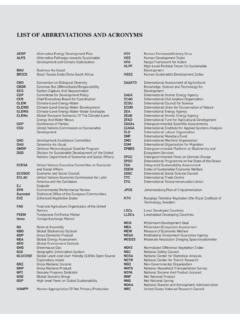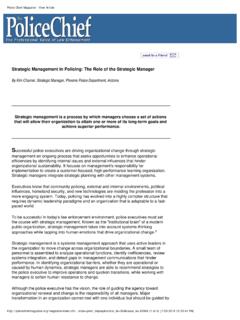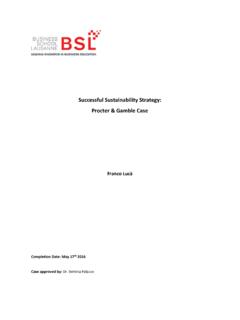Transcription of National Immunization Program
1 National Immunization Program Reaching Every Child Comprehensive Multi-Year Plan 2068-2072 (2011- 2016) Child Health Division Department of Health Services Ministry of Health & Population Kathmandu, Nepal May, 2011 Table of contents Executive Summary .. 1 Chapter 1: 5 Chapter 2: Situation Analysis .. 9 Chapter 3: Goal, Objectives and 27 Chapter 4: Indicators, strategies, activities, timelines and responsible areas .. 30 Chapter 5: Financial Planning .. 49 Annex 1: MOHP Organizational Structure .. 58 Annex 2: Annual Work Plan 2011-2012 Acronyms ADS Auto-disable Syringes AEFI Adverse Events Following Immunization AFP Acute Flaccid Paralysis BCC Behavior Change Communication BCG Bacille Calmette-Guerin CB-IMCI Community based Integrated Management of Childhood Illness CDR Central Development Region CHD Child Health Division CCA Cold Chain Assistant DHO District Health Office/District Health Officer DoHS Department of Health Services DPHO District Public Health Office/District Public Health Officer DPT Diphtheria, Pertussis.
2 Tetanus Vaccine DQSA Data Quality Self Assessment EHCS Essential Health Care Services EDCD Epidemiology and Disease Control Division EDR Eastern Development Region EDP External Development Partner EPI Expanded Programme on Immunization EWARS Early Warning and Reporting System FCHV Female Community Health Volunteer FHD Family Health Division FSP Financial Sustainability Plan FWDR Far Western Development Region FY Fiscal Year GAVI Global Alliance for Vaccines and Immunization GIVS Global Immunization Vision and Strategy Hep B Hepatitis B Hib Haemophilus influenzae type b Vaccine HMIS Health Management Information System HP Health Post HR Human Resource ICC Interagency Coordination Committee IHP International Health Partnership JE Japanese Encephalitis LMD Logistics Management Division MCH Maternal & Child Health MDG Millennium Development Goal MDV Multi Dose Vial MLM Mid-level Manger MOHP Ministry of Health and Population MoLD Ministry of Local Development MMR Measles, Mumps.
3 Rubella Vaccine MNT Maternal and Neonatal Tetanus MR Measles and Rubella Vaccine MWDR Mid-Western Development Region NGO Non-governmental Organization NHEICC National Health Education, Information and Communication Center NHSP National Health Sector Programme NHSP-IP National Health Sector Programme Implementation Plan NHTC National Health Training Center NID National Immunization Day NIP National Immunization Program NPHL National Public Health Laboratory NT Neonatal Tetanus OPV Oral Polio Vaccine PHC Primary Healthcare Center PRSP Poverty Reduction Strategy Papers RHD Regional Health Directorate RED Reach Every District RT Refrigerator Technician SEAR South East Asia Region SHP Sub Health Post SIA Supplemental
4 Immunization Activity Td Tetanus Diphtheria Vaccine TT Tetanus Toxoid UNICEF United Nations Children s Fund USAID United States Agency for International Development VDC Village Development Committee VPD Vaccine-Preventable Disease WIC Walk-in-Cooler WIF Walk-in-Freezer WDR Western Development Region WPV Wild Poliovirus WHO World Health Organization Nepal cMYP 2012-2016 (Page: 1)Executive Summary As per the Nepal's interim constitution 2006, health is considered as a right of the people. The Ministry of Health and Population (MOHP) in its Nepal National Health Sector Programme Implementation Plan (NHSP-II, 2010-2015) has a goal to improve the health and nutritional status of the Nepali population, especially for the poor and socially excluded.
5 In the area of child health, it has a target to reduce under five mortality to a level of 38 and infant deaths to 32 per 1,000 live births by 2015 with several interventions including: sustaining community based integrated management of childhood illness (CB-IMCI), maintaining Immunization coverage above 90% and scaling up community based newborn care. The Immunization Program is one of the government's highest priority programs . The Immunization Program has helped in reducing the deaths of children and mothers from vaccine preventable diseases (VPDs) and has contributed in achieving Millennium Development Goals (MDG) 4 and 5. The Government through its policy documents has emphasized reaching poor and marginalized population with equitable services including Immunization . Since the past decades new vaccines are available in the markets, and the Government is keen to provide all available means to reduce morbidity and mortality.
6 In this regard it is essential to have a long term Immunization plan with priority activities identified and as well as a financial sustainability plan. The comprehensive multi-year plan 2011-2016 provides a plan for the next five years to achieve the Immunization related goals expressed by the Government in various policy documents, the MDGs and WHAs resolutions and as well as different National and international forums. The plan also takes into consideration the Global Immunization Vision and Strategy (GIVS). The objectives, strategies and activities set forth in the plan provide the framework required to meet the goal of reducing infant and child mortality and morbidity associated with vaccine-preventable diseases (VPDs). Furthermore, this plan addresses new challenges and expands the previous plan by providing guidelines for the introduction of new vaccines, eradication, elimination and control of targeted VPDs and strengthening of routine Immunization .
7 The multi-year plan has been developed with extensive discussion and participation of government, non-governmental organizations (NGOs) and partner agencies. The development of the plan started with identification of problems, constraints, key issues and National priorities. The plan sets goals, objectives, strategies, milestones, activities with timeline, indicators and associated costing and financial sustainability plan. Nepal cMYP 2012-2016 (Page: 2)Goal, objectives, strategies and key activities (2011/12-2015/16) The goal set for next five years is as follows: To reduce child mortality, morbidity, and disability associated with vaccine preventable diseases. The objectives, strategies and key activities are as follows: Objective 1: Achieve and maintain at least 90% vaccination coverage for all antigens at National and district level by 2016 Proposed key strategies: Increase access to vaccination by implementing RED strategies in every district Enhance human resources capacity for Immunization management Review Program performance at all levels Strengthen communication, social mobilization, and advocacy activities Strengthen Immunization data analysis, monitoring and use at all levels Strengthen Immunization services in the municipalities Strengthen supportive supervision and monitoring activities Ensure adequate and sustainable financing for the Immunization Program Objective 2.
8 Ensure access to vaccines of assured quality and with appropriate waste management Proposed key strategies: Strengthen the vaccine management system Strengthening cold chain systems at all levels Increase the capacity of cold chain staff Explore various methods of waste disposal Objective 3: Achieve and maintain polio free status The last case of indigenous wild poliovirus in Nepal was detected in 2000. However 4-6 cases of imported WPV has been detected each year in 2005-2008 and again in 2010 (Nepal was polio-free from 2001 to 2004 and 2009). Proposed key strategies: Achieve and maintain immunity levels to stop transmission of poliomyelitis Respond adequately and timely to outbreak of poliomyelitis with appropriate vaccine Achieve and maintain certification standard AFP surveillance at district level Develop post eradication strategic guideline Nepal cMYP 2012-2016 (Page: 3)Objective 4: Maintain maternal and neonatal tetanus elimination status Nepal achieved MNT elimination status in 2005.
9 The government is planning several activities to maintain MNT elimination status. The key strategies include: Achieve and maintain at least >80% TT2+ coverage for pregnant women in every districts Conduct Td follow up campaigns in high risk districts Expand school based Immunization Program Continue integrated VPD surveillance including NT Objective 5: Achieve measles elimination status by 2016 Nepal has achieved the mortality reduction goal of decreasing measles deaths by >90% when compared to 2003 data. Nepal has taken further steps and has targeted measles for elimination by 2016. The key strategies include: Achieve and sustain immunity level to reduce measles incidence to elimination level Investigate all suspected measles outbreaks with Program response Continue expansion of case-based measles surveillance Objective 6: Accelerate control of vaccine-preventable diseases through introduction of new and underused vaccines Key strategies: Introduction of new and under-used vaccines (rubella, pneumo, typhoid, rota) based on disease burden and financial sustainability in the country Expansion of cold chain capacity at all levels for introduction of new vaccines Objective 7: Strengthen and expand VPD surveillance Currently the integrated surveillance of VPDs targeted for eradication, elimination and control (AFP, measles, JE and NNT) is ongoing.
10 Key strategies: Expand VPD surveillance Strengthen staff capacity to accommodate additional laboratory surveillance procedures Control of JE, CRS/Rubella and other VPDs Objective 8: Continue to expand Immunization beyond infancy Currently TT Immunization has been provided to school children of grade one in 12 districts. The government plans to expand the school based Immunization Program to other districts and as well add new antigens including typhoid Nepal cMYP 2012-2016 (Page: 4)Financial sustainability Expenditure in health remains low at percent of GDP and per capita health expenditure at USD in 2006. More than 55 percent (USD ) of total health expenditures is financed through out-of-pocket expenditures by households at the time of service. EDPs finance nearly half of Government spending on health, and the substantial gains achieved in reducing child and maternal mortality will not be sustained without continued external support.





